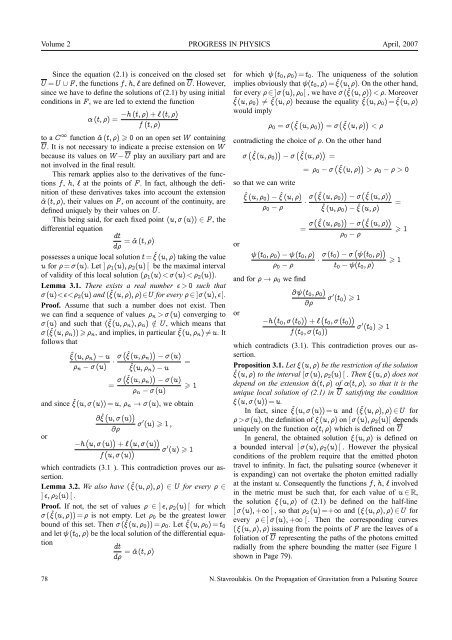ISSUE 2007 VOLUME 2 - The World of Mathematical Equations
ISSUE 2007 VOLUME 2 - The World of Mathematical Equations
ISSUE 2007 VOLUME 2 - The World of Mathematical Equations
Create successful ePaper yourself
Turn your PDF publications into a flip-book with our unique Google optimized e-Paper software.
Volume 2 PROGRESS IN PHYSICS April, <strong>2007</strong><br />
Since the equation (2.1) is conceived on the closed set<br />
U = U ∪ F , the functions f, h, ℓ are defined on U. However,<br />
since we have to define the solutions <strong>of</strong> (2.1) by using initial<br />
conditions in F , we are led to extend the function<br />
α (t, ρ) =<br />
−h (t, ρ) + ℓ (t, ρ)<br />
f (t, ρ)<br />
to a C ∞ function ˆα (t, ρ) � 0 on an open set W containing<br />
U. It is not necessary to indicate a precise extension on W<br />
because its values on W − U play an auxiliary part and are<br />
not involved in the final result.<br />
This remark applies also to the derivatives <strong>of</strong> the functions<br />
f, h, ℓ at the points <strong>of</strong> F . In fact, although the definition<br />
<strong>of</strong> these derivatives takes into account the extension<br />
ˆα (t, ρ), their values on F , on account <strong>of</strong> the continuity, are<br />
defined uniquely by their values on U.<br />
This being said, for each fixed point (u, σ (u)) ∈ F , the<br />
differential equation<br />
dt<br />
= ˆα (t, ρ)<br />
dρ<br />
possesses a unique local solution t = ˆξ (u, ρ) taking the value<br />
u for ρ = σ (u). Let ] ρ1(u), ρ2(u) [ be the maximal interval<br />
<strong>of</strong> validity <strong>of</strong> this local solution (ρ1(u) < σ (u) < ρ2(u)).<br />
Lemma 3.1. <strong>The</strong>re exists a real number ɛ > 0 such that<br />
σ (u) ρ0 − ρ > 0<br />
∙ σ� ˆξ (u, ρ0) � − σ � ˆξ (u, ρ) �<br />
ˆξ (u, ρ0) − ˆξ (u, ρ)<br />
= σ� ˆξ (u, ρ0) � − σ � ˆξ (u, ρ) �<br />
∂ψ (t0, ρ0)<br />
∂ρ<br />
ρ0 − ρ<br />
∙ σ (t0) − σ � ψ(t0, ρ) �<br />
t0 − ψ(t0, ρ)<br />
σ ′ (t0) � 1<br />
−h � t0, σ (t0) � + ℓ � t0, σ (t0) �<br />
f (t0, σ (t0))<br />
σ ′ (t0) � 1<br />
=<br />
� 1<br />
� 1<br />
which contradicts (3.1). This contradiction proves our assertion.<br />
Proposition 3.1. Let ξ (u, ρ) be the restriction <strong>of</strong> the solution<br />
ˆξ (u, ρ) to the interval [σ (u), ρ2(u) [ . <strong>The</strong>n ξ (u, ρ) does not<br />
depend on the extension ˆα(t, ρ) <strong>of</strong> α(t, ρ), so that it is the<br />
unique local solution <strong>of</strong> (2.1) in U satisfying the condition<br />
ξ (u, σ (u)) = u.<br />
In fact, since ˆξ (u, σ (u)) = u and ( ˆξ (u, ρ), ρ) ∈ U for<br />
ρ >σ (u), the definition <strong>of</strong> ξ (u, ρ) on [σ (u), ρ2(u)[ depends<br />
uniquely on the function α(t, ρ) which is defined on U<br />
In general, the obtained solution ξ (u, ρ) is defined on<br />
a bounded interval [ σ (u), ρ2(u) [ . However the physical<br />
conditions <strong>of</strong> the problem require that the emitted photon<br />
travel to infinity. In fact, the pulsating source (whenever it<br />
is expanding) can not overtake the photon emitted radially<br />
at the instant u. Consequently the functions f, h, ℓ involved<br />
in the metric must be such that, for each value <strong>of</strong> u ∈ R,<br />
the solution ξ (u, ρ) <strong>of</strong> (2.1) be defined on the half-line<br />
[ σ (u), +∞ [ , so that ρ2 (u) =+∞ and (ξ (u, ρ), ρ) ∈ U for<br />
every ρ ∈ ] σ (u), +∞ [. <strong>The</strong>n the corresponding curves<br />
(ξ (u, ρ), ρ) issuing from the points <strong>of</strong> F are the leaves <strong>of</strong> a<br />
foliation <strong>of</strong> U representing the paths <strong>of</strong> the photons emitted<br />
radially from the sphere bounding the matter (see Figure 1<br />
shown in Page 79).<br />
78 N. Stavroulakis. On the Propagation <strong>of</strong> Gravitation from a Pulsating Source

















